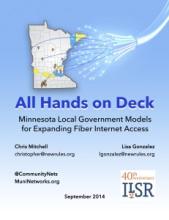
Fast, affordable Internet access for all.

Update: Read an updated version of this report, published in July 2021, here, titled Minnesota Broadband: Land of 10,000 Connectivity Solutions [pdf]. It revisits all of the below communities to see how they fared over the intervening years, while adding new counties, communities, and, for the first time, two local Internet Service Providers.
In our latest report, All Hands On Deck: Minnesota Local Government Models for Expanding Fiber Internet Access, we analyze how local governments in 12 Minnesota communities are expanding 21st century Internet access to their citizens.
In 2010, the Minnesota legislature set a goal for 2015 - universal access to high speed broadband throughout the state. Even though we have the technology to make that vision a reality, large swaths of the state will not meet that goal. Nevertheless, local folks who have chosen to take control of their connectivity are finding a way to exceed expectations, surpassing the choices in many metropolitan regions.
Some of the communities we cover include:
We delved into networks in Anoka, Carver, Cook, Lake, and Scott Counties. The report also shares developments in the municipalities of Chaska, Buffalo, and Monticello. We tell the story of RS Fiber, located in Sibley and part of Renville County. These communities provide examples of municipal networks, a variety of public private partnerships, and "dig once" policies.
This week in Minnesota, the governor’s office began accepting applications for the state’s new $20 million initiative Border-to-Border program. We hope this new report will serve as a resource for potential applicants and other community leaders across the U.S. interested in taking charge of their broadband destinies.
